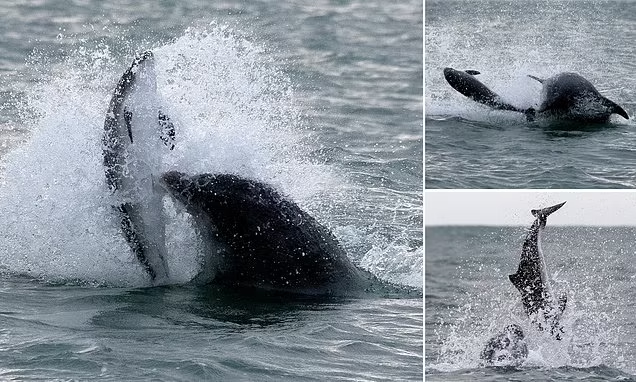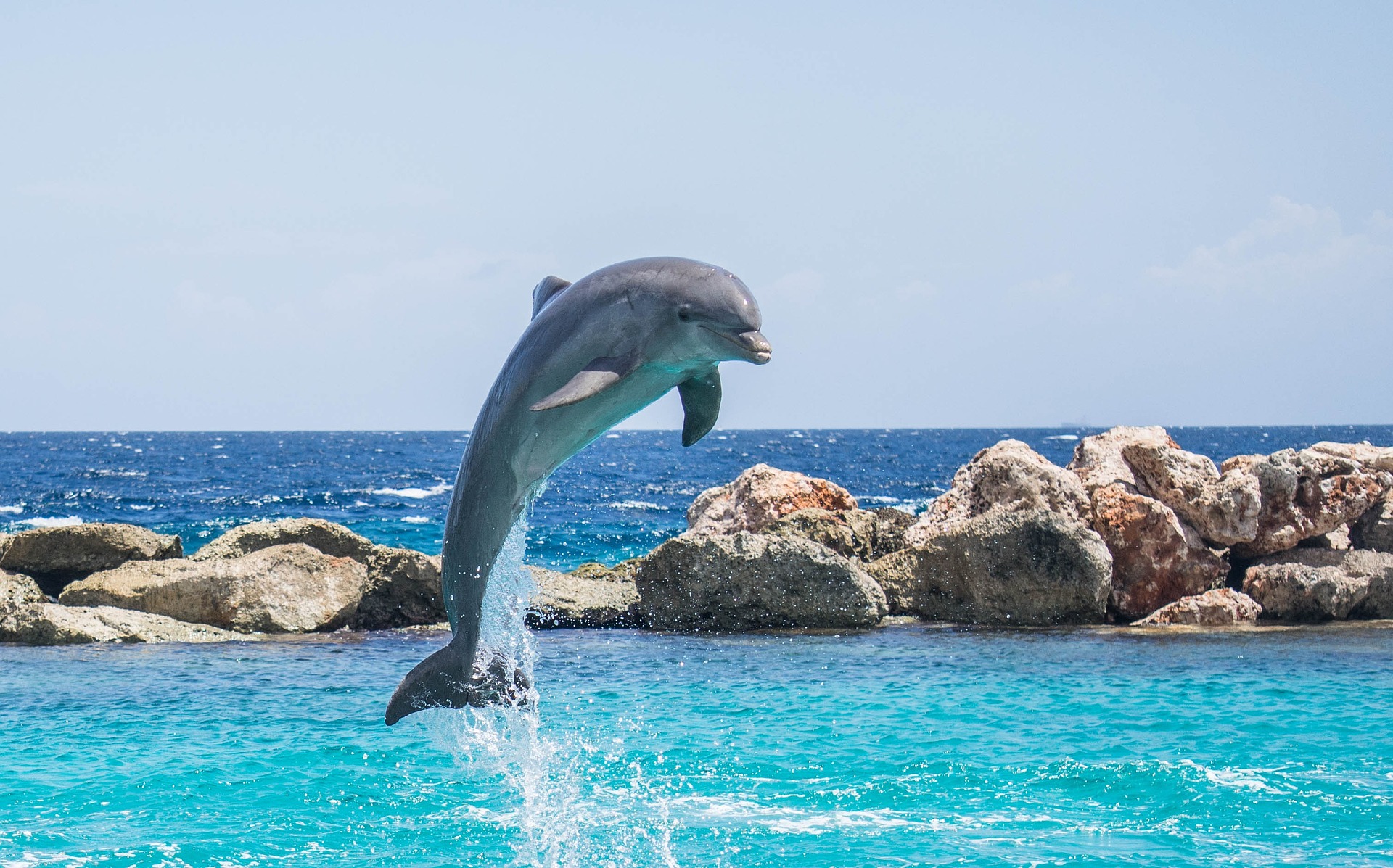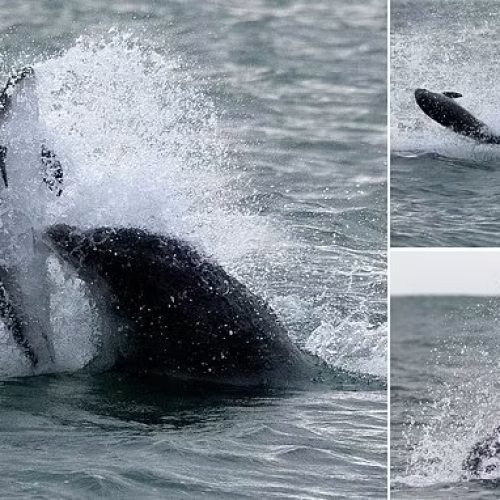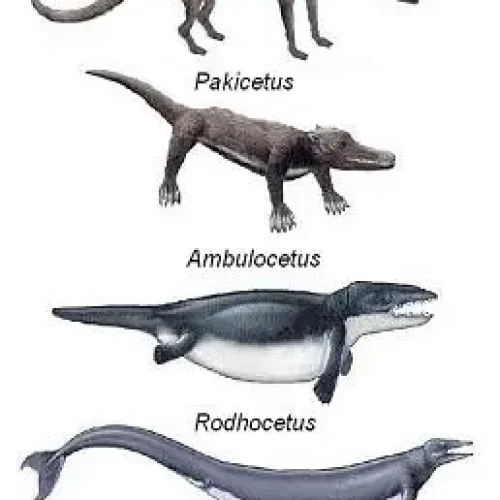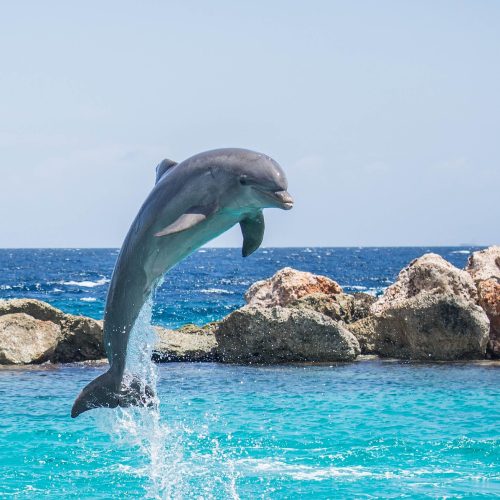From the icy waters of the Arctic to the sun-drenched tropics, these remarkable marine mammals have adapted to an astonishing array of habitats.
Discover the secrets of where dolphins are found, the challenges they face, and the awe-inspiring diversity of species that grace our planet’s waters. Join us as we explore the global map of dolphin populations.
In this article
DOLPHIN SPECIES DIVERSITY ACROSS THE GLOBE
Dolphins belong to the family Delphinidae, which is part of the larger order Cetacea that also includes whales and porpoises.
The Delphinidae family is incredibly diverse, with 36 currently recognized species of oceanic dolphins and a few additional species of river dolphins. Each species has its own unique characteristics, behaviors, and habitat preferences.
Some well-known species include the common bottlenose dolphin (Tursiops truncatus), famous for its friendly interactions with humans, and the orca or killer whale (Orcinus orca), the largest member of the dolphin family.
YOU MAY ALSO LIKE – Where are the most dolphins found? Top 10 global spots to observe dolphins in their natural habitat
Other notable species are the spinner dolphin (Stenella longirostris), known for its acrobatic leaps and spins, and the Amazon river dolphin (Inia geoffrensis), a freshwater species with a distinctive pink coloration.
The exact number of dolphin species is a topic of ongoing research and debate among marine biologists. As of 2023, most experts agree there are around 40 distinct species, but this number may change as new scientific evidence emerges.
Some populations that were once considered separate species have been reclassified as subspecies, while new species have occasionally been discovered in remote or understudied areas.
For example, in 2011, researchers identified the Burrunan dolphin (Tursiops australis) as a new species endemic to the coastal waters of southeastern Australia.
This discovery highlighted the importance of continued research to better understand the full extent of dolphin biodiversity.
Dolphins are classified using a hierarchical taxonomic system that organizes species based on their evolutionary relationships and shared characteristics. At the highest level, dolphins are grouped within the order Cetacea, which includes all whales, dolphins, and porpoises.
Within Cetacea, dolphins are further classified into the family Delphinidae, which is divided into several subfamilies, genera, and finally, individual species. This classification system helps scientists understand the evolutionary history and ecological roles of different dolphin species.
YOU MAY ALSO LIKE – Why do dolphins strand themselves on the beach? From environmental factors to health problems
MAJOR OCEAN HABITATS OF DOLPHINS
Dolphins are found in a variety of aquatic environments around the world, from shallow coastal waters to deep ocean basins and even freshwater river systems.
Each habitat presents unique challenges and opportunities that have shaped the evolution and adaptations of different dolphin species.
Many dolphin species, such as bottlenose dolphins and spotted dolphins (Stenella frontalis), thrive in coastal and shallow water habitats. These areas provide abundant prey, such as fish and squid, and offer protection from predators.
Coastal dolphins often form complex social groups and exhibit a wide range of behaviors, including cooperative hunting, playing, and nurturing their young.
Shallow water habitats also include estuaries, bays, and lagoons, which are important nursery areas for many dolphin populations. For example, the Indian
Ocean humpback dolphin (Sousa plumbea) relies on the sheltered waters of the Indus Delta in Pakistan for breeding and raising calves.
Some dolphin species, like the striped dolphin (Stenella coeruleoalba) and the short-beaked common dolphin (Delphinus delphis), are pelagic, meaning they inhabit the open ocean far from shore.
These dolphins are adapted to the challenges of life in the vast, deep waters, where they hunt for prey such as fish, squid, and crustaceans.
Pelagic dolphins often form large, dynamic groups that can number in the hundreds or even thousands of individuals.
These groups work together to locate and capture prey, communicate using a variety of vocalizations, and protect each other from predators like sharks and killer whales.
While most dolphins are marine species, a few unique species have adapted to life in freshwater river systems.
The most well-known of these are the river dolphins of South America and Asia, including the Amazon river dolphin, the Ganges river dolphin (Platanista gangetica), and the Yangtze river dolphin (Lipotes vexillifer), which is sadly believed to be functionally extinct.
River dolphins have evolved special adaptations to navigate the complex, murky waters of their riverine habitats. For instance, the Ganges river dolphin has a long, narrow snout filled with teeth to catch fish in the sediment-laden waters of the Ganges and Brahmaputra rivers.
Freshwater dolphin populations face numerous threats, including habitat degradation, pollution, and entanglement in fishing gear. Conservation efforts are crucial to protect these unique and endangered species for future generations.
YOU MAY ALSO LIKE – Why is swimming with dolphins a unique, transformative experience?
DOLPHIN POPULATIONS IN THE ATLANTIC OCEAN
The Atlantic Ocean is home to a diverse array of dolphin species, each adapted to the unique conditions of their habitat. From the cool waters of the North Atlantic to the tropical coasts of South America and Africa, dolphins can be found throughout this vast ocean basin.
In the North Atlantic, common dolphin species include the short-beaked common dolphin (Delphinus delphis) and the Atlantic white-sided dolphin (Lagenorhynchus acutus).
These agile swimmers are often seen in large pods, working together to hunt fish and squid. The Atlantic spotted dolphin (Stenella frontalis) is another frequent sighting, recognized by the distinctive spots that develop on its skin as it matures.
Along the Atlantic coasts of Europe and Africa, bottlenose dolphins (Tursiops truncatus) are a familiar presence.
These intelligent and charismatic mammals can be found in coastal waters, estuaries, and even venturing into rivers. In the Mediterranean Sea, striped dolphins (Stenella coeruleoalba) are abundant, known for their striking coloration and acrobatic leaps.
The South Atlantic is a hotspot for dolphin diversity, with species like the dusky dolphin (Lagenorhynchus obscurus) and the Commerson’s dolphin (Cephalorhynchus commersonii) found in the cool, productive waters off Argentina and Chile.
In the warmer waters closer to the equator, spinner dolphins (Stenella longirostris) and Clymene dolphins (Stenella clymene) delight observers with their spinning aerial displays.
One of the most unique dolphin habitats in the Atlantic is the Amazon River basin, where the Amazon river dolphin, or boto (Inia geoffrensis), resides.
This endangered species has adapted to life in freshwater, navigating the murky waters with echolocation. The tucuxi (Sotalia fluviatilis), a smaller river dolphin species, shares this remarkable ecosystem.
PACIFIC OCEAN: A HAVEN FOR DIVERSE DOLPHIN SPECIES
The Pacific Ocean, the world’s largest, is a haven for an incredible diversity of dolphin species. From the frigid waters of the North Pacific to the warm seas of the South Pacific, dolphins have adapted to thrive in every corner of this immense ocean.
In the Eastern Pacific, the Pacific white-sided dolphin (Lagenorhynchus obliquidens) is a common sight, often seen porpoising through the waves in large pods.
The Risso’s dolphin (Grampus griseus), with its distinctive scarring and tall dorsal fin, is another frequent sighting. In the warmer waters off the coast of Central America, the pantropical spotted dolphin (Stenella attenuata) and the spinner dolphin (Stenella longirostris) are abundant.
The Western Pacific is home to some of the most abundant dolphin populations in the world. In the waters around Japan and Taiwan, the Indo-Pacific bottlenose dolphin (Tursiops aduncus) and the Indo-Pacific humpback dolphin (Sousa chinensis) are common coastal residents.
Further south, in the Coral Triangle region of Southeast Asia, the Irrawaddy dolphin (Orcaella brevirostris) and the Fraser’s dolphin (Lagenodelphis hosei) can be found in the warm, clear waters.
Sadly, some Pacific dolphin species are facing significant threats. The Yangtze River dolphin, or baiji (Lipotes vexillifer), was once found throughout China’s Yangtze River but is now considered functionally extinct due to habitat loss, pollution, and entanglement in fishing gear.
The critically endangered Hector’s dolphin (Cephalorhynchus hectori) is found only in the coastal waters of New Zealand, with a population estimated at just over 10,000 individuals.
The Pacific Islands region is home to several dolphin species found nowhere else on Earth.
The Hawaiian spinner dolphin (Stenella longirostris longirostris) is a subspecies endemic to the Hawaiian Islands, known for its acrobatic spinning behavior.
The Guam dolphin (Stenella coeruleoalba guami) is a subspecies of the striped dolphin found only in the waters around the Mariana Islands.
INDIAN OCEAN DOLPHIN POPULATIONS
- Ganges River Dolphin: An Endangered Species
The Ganges River Dolphin, also known as the South Asian River Dolphin, is a critically endangered species found primarily in the Ganges and Brahmaputra Rivers of India and Bangladesh.
These freshwater dolphins have adapted to life in the murky, sediment-laden waters of these major river systems.
With an estimated population of less than 2,000 individuals remaining, the Ganges River Dolphin faces numerous threats, including habitat loss due to dam construction, pollution, and accidental entanglement in fishing gear.
Conservation efforts, such as the establishment of protected areas and awareness campaigns, are crucial for the survival of this unique dolphin species.
- Irrawaddy Dolphins of Southeast Asia
Irrawaddy dolphins, named after the Irrawaddy River in Myanmar, are found in the coastal waters and estuaries of Southeast Asia, including parts of the Indian Ocean.
These small, stocky dolphins are known for their distinctive rounded heads and short beaks. Irrawaddy dolphin populations are scattered throughout their range, with notable concentrations in the Mekong River of Cambodia and Laos, the Mahakam River of Indonesia, and the Malampaya Sound in the Philippines.
These dolphins face threats from habitat degradation, bycatch in fishing nets, and pollution.
Conservation initiatives, such as community-based ecotourism and sustainable fishing practices, are being implemented to protect Irrawaddy dolphins and their habitats.
- Dolphins Inhabiting the Red Sea and Persian Gulf
The warm, saline waters of the Red Sea and Persian Gulf are home to several dolphin species, including the Indo-Pacific bottlenose dolphin, the spinner dolphin, and the Indo-Pacific humpback dolphin.
These dolphins have adapted to the unique environmental conditions of these semi-enclosed seas, which are characterized by high water temperatures and salinity levels.
Dolphin populations in the Red Sea and Persian Gulf face challenges such as coastal development, oil and gas exploration, and marine traffic.
- Indo-Pacific Bottlenose Dolphins
Indo-Pacific bottlenose dolphins are widely distributed throughout the Indian Ocean, ranging from the eastern coast of Africa to the western Pacific Ocean.
These dolphins are known for their adaptability, inhabiting a variety of marine environments, including coastal waters, estuaries, and even rivers. Indo-Pacific bottlenose dolphins are social animals, often forming groups of 10-30 individuals.
They are also known for their intelligence and playful behavior, making them a popular attraction for dolphin-watching tours. However, like many other dolphin species, Indo-Pacific bottlenose dolphins face threats from habitat degradation, bycatch in fishing gear, and marine pollution.
Conservation measures, such as the implementation of sustainable tourism practices and the reduction of marine debris, are crucial for the long-term protection of these charismatic dolphins.
CONSERVATION CHALLENGES FACING DOLPHIN POPULATIONS
Dolphin populations around the world face a multitude of threats, primarily due to human activities. Habitat degradation is a major concern, as coastal development, pollution, and climate change alter the delicate ecosystems that dolphins depend on.
The accumulation of marine debris, particularly plastic waste, poses a significant risk to dolphins, as they can become entangled in or ingest these materials. Bycatch, or the accidental capture of dolphins in fishing gear, is another significant threat, causing injury and mortality to countless individuals each year.
Additionally, underwater noise pollution from shipping, oil and gas exploration, and military activities can disrupt dolphin communication and behavior.
Addressing these threats requires a concerted effort from governments, conservation organizations, and individuals to promote sustainable practices and protect dolphin habitats.
Efforts to Protect Endangered Dolphin Species
Conservation efforts are underway to protect endangered dolphin species around the world.
These initiatives involve a multi-faceted approach, including research, habitat protection, and community engagement. Scientists are working to better understand the biology, behavior, and population dynamics of endangered dolphin species, which informs conservation strategies.
The establishment of marine protected areas and the implementation of fishing regulations help to safeguard critical dolphin habitats and reduce bycatch.
- The Role of Marine Protected Areas in Dolphin Conservation
Marine protected areas (MPAs) play a vital role in the conservation of dolphin populations worldwide.
These designated areas provide safe havens for dolphins, protecting them from various threats and allowing their populations to recover. MPAs can encompass a range of habitats, from coastal waters to offshore regions, and are designed to restrict human activities that may harm marine life.
Within MPAs, fishing may be regulated or prohibited, and boat traffic can be managed to minimize disturbance to dolphins.
These areas also serve as important research sites, enabling scientists to study dolphin behavior and ecology in relatively undisturbed environments.
The success of MPAs in dolphin conservation depends on effective management, enforcement, and community support.
By working with local stakeholders, such as fishermen and tourism operators, conservationists can ensure that MPAs provide long-term benefits for both dolphins and the communities that depend on marine resources.
- How You Can Help Support Dolphin Conservation
Everyone can contribute to the conservation of dolphin populations around the world. One of the simplest ways to help is by reducing your plastic consumption and properly disposing of waste to prevent it from ending up in the oceans.
When engaging in dolphin-watching activities, choose responsible tour operators that follow guidelines to minimize disturbance to the animals.
You can also support conservation organizations through donations or volunteering, helping to fund research, habitat protection, and education initiatives. Spreading awareness about the importance of dolphin conservation and the threats they face is another valuable way to contribute.
By sharing your knowledge with others and encouraging them to take action, you can help build a global community of dolphin advocates. Remember, every individual effort, no matter how small, can make a difference in the fight to protect these remarkable marine mammals and the oceans they call home.

